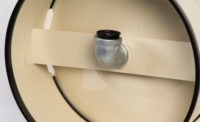
It’s isolated, noisy and messy – but, if successful, could be beneficial to Camp Lemonnier and local the local population in the republic of Djibouti, a small country in northeast Africa. Thanks to new equipment, the U.S. Army National Guard’s 257th Engineer Team drilled four water test wells in different locations here.
“The wells are part of a study to determine if pulling water from a beach aquifer is a viable option for removing Camp Lemonnier from the Djiboutian Fresh Water Aquifer and leaving that resource solely for the Djiboutians,” explains U.S. Army Capt. Joseph Bzdok, 257th Engineer Team commander.
The well development project directly supports Camp Lemonnier’s initiative to identify alternative well locations, and assist in future development of camp infrastructure. The team conducted a 24-hour, constant-rate test for future development and testing of camp aquifer water tables. A constant rate test is a constant pumping of a well to determine what amount of water can be pumped out at a sustained rate for an indefinite amount of time.
“The pump test right now is pumping at 540 gallons per minute,” says Bzdok. “If the lowering of the water table level of the static water level does not change significantly, we know it can sustain that rate of 540 gallons per minute.”
The team finished the last of four test wells four days ahead of schedule.
“The sandy soil conditions have allowed us to drill faster, but the sandy soil also is harder to stabilize from collapsing down the hole,” Bzdok notes.
“The sea water level is very shallow, and doesn’t support heavy equipment operations well,” says U.S. Army Sgt. 1st Class Shane Banks, 257th Engineer Team drill leader. Bzdock adds that the rig itself weighs 80,000 pounds.
“There’s less than an eight-inch crust of soil,” says Bzdok. “The rest is goop underneath.” The team set up the rig in three locations around the final well site, but the weight of the rig caused it to sink into the soft sand and underlying glop.
“The third hole had to be abandoned after it was drilled and cased, and a fourth well had to be drilled for the pump test (due to the soil collapsing down the hole.) So the unit actually drilled four complete holes, and cased three of them,” explains Bzdok.
The team is using this experience as on-the-job training to work out any kinks in the new equipment before using the machines out in the field. “It is a lot easier to deal with equipment needs and repairs here than eight hours away,” says Banks about their upcoming missions throughout the Combined Joint Task Force – Horn of Africa’s area of responsibility.
Despite the challenges and constant maintenance issues, Banks says the team knows the wells and testing will “help support the success of the camp, and the health and missions of the personnel stationed at Camp Lemonnier.”
ND




Report Abusive Comment